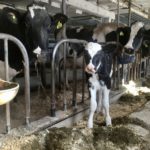I don’t really need to tell you how important colostrum is-you’ve probably heard it before. But did you know how important? Colostrum delivers, along with Igs ( immunoglobulins), important steroids such as insulin, prolactin and leptin. These steroids “talk” to gut, stimulating the gut to grow, be healthier, have greater surface area-coming together to build a strong immune system. It also stimulates overall growth in the calf. Feeding good colostrum is the most important thing you can do to set the calf up for life. But it isn’t always easy. Here are some things you can do to improve the effectiveness of feeding colostrum:
1. Feed colostrum within 4 hours of birth
This is ideal for getting the most out of colostrum. Feeding as soon after birth as possible.
2. Feed 10% of the calf’s bodyweight
This usually means about 1 gallon for most heifer holstein calves. Feed it by bottle or tube it.
3. Colostrum should score 22 or greater on a Brix refractometer.
Color and thickness can tell you a little abut quality, but to really know if the colostrum is good or not, use a Brix meter. If it is not as strong-22 or better-save or freeze for a second feeding.
4. Have good records.
In addition to recording the calf’s birth, and if there were any problems with freshening, it helps to record colostrum fed-amount and quality-in case of future trouble with the calf.
5. A second feeding of colostrum should be fed 6-12 hours later.
This colostrum or colostrum supplement can be fed at a lower rate-2 to 3 quarts. A score of 18 on the brix meter works for the second feeding.
6. Use a supplement
Colostrum supplements are not as good as natural colostrum. But they are better than poor quality or no colostrum. Use if you need to improve low testing colostrum or if there is little or no colostrum available from the cow.
